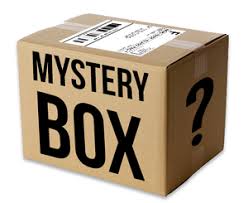
Mystery Boxes
Mystery Boxes
Order Instructions:
Overview: Mystery Boxes
Find a small cardboard or opaque plastic box with a lid, such as a small jewelry box. Ask someone to place 1-3 small objects in the box and then seal it with tape and return it to you. DO NOT OPEN THE BOX!
• Without opening the box, make and write observations about what is in the box.
• Draw a conclusion of what you believe the item(s) in the box to be, based on your observations.
• Give the box to someone else, and have that person write down observations and conclusions about what’s in the box.
• Report your observations and conclusions to your colleagues.
Data Chart
Begin by recording yourself as the “Scientist.” Record an observation, and immediately draw a conclusion rather that performing a number of observations before recording your conclusions. Do not delete any conclusions you later decide are incorrect. (You may add rows as needed.)
Have another person follow the same procedure, recording his/her observations and conclusions. (You may add rows as needed.)
Put your final conclusion (based upon your own and your “partner’s” data) in bold in the last row of the data chart. Then post your chart on the Discussion Board.
Chart (three rows:
Scientist Observations Conclusions
SAMPLE ANSWER
Mystery Boxes
Introduction
Mystery boxes are used as an analogy for science where scientists manipulate sealed boxes and attempt to determine inner contents. The boxes are used to illustrate how scientific knowledge is fundamentally uncertain (Matthews, 2006). The essay in the form of a data chart, illustrates how two individuals, a scientist and a partner, observed a sealed mystery box and came up with the assumptive conclusion as to what the inner structures are.
Data Chart
| SCIENTIST | |
| Observation | 1. When lifted, the box is relatively light suggesting the object is not dense.
2. When the box is tilted, objects move with ease from one corner to another. This precludes the objects are not arranged in a fixed manner. 3. Upon shaking the box, objects produced a discreet clanking sound which suggests it is a small metal object.
|
| Conclusion | From the above observations, I came to the conclusion the objects are metallic most likely small nuts judging from the ease of movement and the sound made when they are struck against each other. |
| PARTNER | |
| Observation | 1. From initial observation of the box, small and compact, assumption is that the objects inside must be relatively small.
2. On lifting the box, observation is that it is light and almost weightless. This affirms the latter presumption that the object is small. 3. Upon tilting and shaking the box, objects hit against each other producing a distinct sound akin to small marbles.
|
| Conclusion | From the above observations, I came to the conclusion that the objects in the mystery box are most likely marbles. Particularly, this is with regard to the light weight, how the item moves and distinct sound made when moved. |
| After analyzing both observations tabled, conclusion arrived at is that the objects in the mystery box are small and metal like, most likely to be either a nut or a marble. | |
References
Matthews, B. (2006). Engaging Education: Developing Emotional Literacy, Equity and Co-education. London: Open University Press.
We can write this or a similar paper for you! Simply fill the order form!




